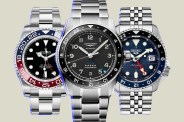The Seiko 5 isn’t just one watch. Instead, hundreds of watches with different designs, intended for different uses, have carried the emblematic shield logo with the 5 in the center. In fact, the watches have been signed several different ways — Seiko 5, Seiko 5 Sports, Seiko Sportsmatic 5, Seiko 5 Actus — and used a range of different automatic movements.
When it was introduced in 1963, the Seiko Sportsmatic 5 heralded multiple innovations: The first was the Diaflex mainspring, Seiko’s unbreakable mainspring. Another was the Diashock shock-resistant design, Seiko’s answer to the Swiss Incabloc system. Yet another was overall water resistance — although in those days the words “water proof” were used (a labeling that would have the Federal Trade Commission scrambling their lawyers if it occurred today).
In any case, this third attribute was less a technological innovation and more an innovative design criteria for the Seiko 5 sub-brand.

So what does the “5” mean anyway? There is some disagreement. Tradition says it’s for the following five key attributes of all Seiko 5 watches:
- The Diaflex mainspring
- The Diashock system
- Automatic winding
- Day/date indication
- Water resistance
(Some sources combine Diaflex and Diashock while separating Day and Date.)




